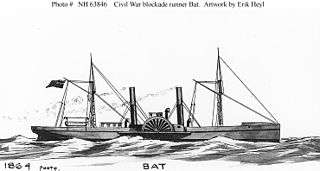
The Peninsula campaign of the American Civil War was a major Union operation launched in southeastern Virginia from March to July 1862, the first large-scale offensive in the Eastern Theater. The operation, commanded by Major General George B. McClellan, was an amphibious turning movement against the Confederate States Army in Northern Virginia, intended to capture the Confederate capital of Richmond. McClellan was initially successful against the equally cautious General Joseph E. Johnston, but the emergence of the more aggressive General Robert E. Lee turned the subsequent Seven Days Battles into a humiliating Union defeat.

CSS Virginia II was a Confederate Navy steam-powered ironclad ram laid down in 1862 at the William Graves' shipyard in Richmond, Virginia. Acting Constructor William A. Graves, CSN, was the superintendent in charge of her construction. In order to conserve scarce iron plating, he ordered the ship's armored casemate shortened from the specifications given in John L. Porter's original building plans; in addition, the ship's iron-plating, while six inches thick on the casemate's forward face, was reduced to five inches on her port, starboard, and aft faces. Due to the shortening of her casemate, the number of her cannon were reduced to a single 11" smoothbore, a single 8" rifle, and two 6.4" rifles.

The first USSSassacus, a wooden, double-ended, side-wheel steamer, was launched on 23 December 1862 by the Portsmouth Naval Shipyard in Kittery, Maine, sponsored by Miss Wilhelmina G. Lambert. Sassacus was commissioned at the Boston Navy Yard on 5 October 1863, Lieutenant Commander Francis A. Roe in command.

CSS Teaser had been the aging Georgetown, D.C. tugboat York River until the beginning of the American Civil War, when she was taken into the Confederate States Navy and took part in the famous Battle of Hampton Roads. Later, she was captured by the United States Navy and became the first USS Teaser.

The first USS Seminole was a steam sloop-of-war in the United States Navy during the American Civil War.

USS Albatross was a screw steamer rigged as a three-masted schooner acquired by the Union Navy during the beginning of the American Civil War. She was outfitted as a gunboat with heavy guns and used in the Union blockade of the waterways of the Confederate States of America.

USS Satellite was a steam powered large tugboat, acquired by the Union Navy during the American Civil War and equipped with two powerful 8-inch guns. She was assigned to the Union blockade of the Confederate States of America.
USS Yankee was a steam-powered side-wheel tugboat acquired by the Union Navy just prior to the outbreak of the American Civil War.

USS Jacob Bell was a sidewheel steamer acquired by the Union Navy for use during the American Civil War. She was one of the oldest vessels so acquired. Her duties included river patrols, guard duty, and other duties as assigned.
USS Anacostia was a steamer, constructed as a tugboat, that was first chartered by the United States Navy for service during the Paraguay crisis of the 1850s and then commissioned as a U.S. Navy ship. She later served prominently in the Union Navy during the American Civil War.
USS Western World was a ship acquired by the Union Navy during the American Civil War. She was used by the Navy to patrol navigable waterways of the Confederacy to prevent the South from trading with other countries.

USS Aroostook was a Unadilla-class gunboat built for the Union Navy during the American Civil War. Aroostook was used by the Navy to patrol navigable waterways of the Confederacy to prevent the South from trading with other countries.

USS Thomas Freeborn was a steam tug acquired by the Union Navy during the American Civil War. She was used by the Navy as a gunboat to patrol navigable waterways of the Confederacy to prevent the South from trading with other countries.
USS Mount Washington was a steamer purchased by the Union Navy during the American Civil War. She was used by the Union Navy as a gunboat assigned to patrol Confederate waterways.

USS Bat was a steamer captured by the Union Navy during the American Civil War. She was used by the Union Navy as a gunboat in support of the Union Navy blockade of Confederate waterways. She was also later assigned to carry President Abraham Lincoln to Richmond, Virginia.
USS Tioga was a large steamer with powerful guns, acquired by the Union Navy during the American Civil War.
USS Alpha was a side wheel paddle steamer acquired by the Union Navy during the American Civil War.
USS Wyandotte, originally USS Western Port, was a steamer acquired by the Navy as a gunboat for the Paraguay expedition in 1858. When the crisis of the American Civil War occurred, she operated in support of the Union Navy blockade of Confederate waterways.

USS Sebago was a large steamer with very powerful guns and four howitzers, purchased by the Union Navy during the beginning of the American Civil War.
USS T. A. Ward was a 284-ton schooner was purchased by the Union Navy during the Union blockade of the Confederate States of America during the American Civil War.











